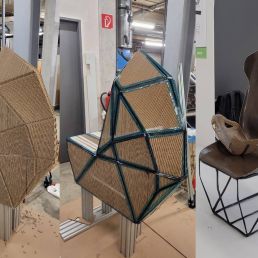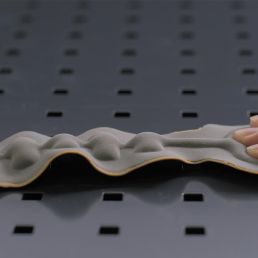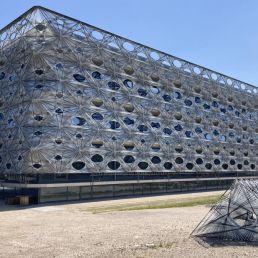
Phono-Luminous Paper
Touch responsive electroluminescent loudspeaker
27 Oktober 2016
Phono-Luminous Paper is a novel material, which produces both light and sound in response to touch. By gently touching the surface of the material, traces of light emerge and the surface itself resonates with a modulating tone. This material was produced in as a part of a series of experimental demonstrations exploring the topic of light and ephemeral materials at Enactive Environments Lab of Zurich University of the Arts.
Paper acts both as a sensor and a sounding device
Unlike any other audio-visual touch display, Phono-Luminous Paper is a completely analogue technology. No computer is present anywhere in the construction. The unique combination of technologies allows this material to act both as a sensor, a display, and a sounding device. In this sense, the interactive capabilities are programmed during the material fabrication and the computation happens inside the the material itself. It serves as a demonstration of the computational qualities, and interactive capabilities of emerging material technologies.
The material is fabricated by screen printing a combination of electrically active layers onto paper stock, which is combined with a protective sheet of polyester film. This fabrication method allows for cost effective mass production and scalability. The flexible nature allows it to be integrated in many different surfaces and forms. Further to this, the device consumes very little power, making it possible to construct not only small devices, but entire walls or spaces from the material.

image: Phono-Luminous Paper run by fluid
The phenomena of light and sound are produced by the combination of electroluminescence and electroacoustic transduction, which are both driven by an alternating current power supply. The material, together with the induction coils in the AC power supply, form a resonant circuit which modulates in response to pressing the the material. The resulting frequency resonates in the material to produce a tone between 340 and 810 Hz.
Other experiments also include devices such as “Liquid Light” where water was used in the construction of an Electroluminescent display. Here the light is produced in interaction with the ebbing and flowing of a stream of water over the films surface.
The source of the light is in the same alternating current that produces the sound. Through a remarkable concurrence of nature, a phosphor of copper-zinc-sulfide will produce light when exposed to the same frequencies of electrical charge as the audible tone. Through the process of electroluminescence, phosphors integrated into the material begin to emit light in response to this high frequency alternating current. The light can range from cool green to blue colour temperatures. Additional colours are also possible with additives during the fabrication process. This conversion from power into visible light occurs with a high degree of efficiency.
images: Luke Franzke
Ecoblaq molecular wood colours
23 March 2024
Ecoblaq is a molecule manipulation method, a natural chemical reaction, making…
Natural fiber reinforced car seat
22 October 2023
The focus of the project "Design for Recycling" is a seat shell that is made…
MotorSkins morphing textiles
19 April 2022
Berlin based start-up MotorSkins designs and produces textiles with embedded…
3D Pioneers Challenge 2022
15 December 2021
The 3D Pioneers Challenge 2022 adresses tech pioneers who pave the way for…
IGNIS – Light from waste heat energy
12 August 2020
The availability of affordable, independent and, above all, clean electrical…
Brake disc with reduced fine dust
21 April 2021
Fine dust endangers our health. One of the main sources is traffic, especially…
Texoversum
15 July 2023
With the "Texoversum", Reutlingen University has put into operation a training…
Invisible Terracotta Solar Rooftile
10 May 2023
The family-run business Dyaqua has developed a technology to integrate a…
Xarvio – Digital Farming
8 January 2021
BASF Digital Farming GmbH has received the renowned Crop Science Award for the…








